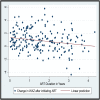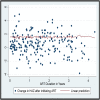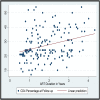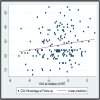Anthropometric Improvement among HIV Infected Pre-School Children Following Initiation of First Line Anti-Retroviral Therapy: Implications for Follow Up
- PMID: 28030557
- PMCID: PMC5193336
- DOI: 10.1371/journal.pone.0167565
Anthropometric Improvement among HIV Infected Pre-School Children Following Initiation of First Line Anti-Retroviral Therapy: Implications for Follow Up
Abstract
Background: Antiretroviral therapy (ART) is a lifesaving intervention for HIV infected children. There is a scarcity of data on immunological recovery and its relation with growth indicators among HIV infected young children. The current study aims to assess the pattern of anthropometric Z-score improvement following initiation of first-line ART among under-five children and the relationship between anthropometric Z-score improvement and immunologic recovery.
Methods: We included under-five children who were on first-line ART at five major hospitals in Addis Ababa, Ethiopia. We measured anthropometry and collected clinical and laboratory data at follow up, and we retrieved clinical and anthropometric data at ART initiation from records. Z-scores for each of the anthropometric indices were calculated based on WHO growth standards using ENA for SMART 2011 software. Linear regression was used to assess the relationship between time on ART and anthropometric Z-score improvement; and the relationship between anthropometric Z-score improvement and immunologic recovery. Multiple linear regression was used to assess the independent predictors of anthropometric Z-score change.
Results: The median age of the participants was 4.1 (Interquartile range (IQR): 3.3-4.9) years. More than half (52.48%) were female. The median duration of follow up was 1.69 (IQR: 1.08-2.63) years. There was a significant improvement in all anthropometric indices at any follow up after initiation of first-line ART (underweight; 39.5% vs16.5%, stunting; 71.3% vs 62.9% and wasting; 16.3% vs 1.0%; p-value< 0.0001). There was an inverse relationship between improvement in weight for age Z-score (WAZ) and duration of ART (R2 = 0.04; F (1, 158); p = 0.013). Height for age Z-score (HAZ) both at the time of ART initiation and follow up has a positive linear relationship with CD4 percentage at follow up (Coef. = 1.92; R2 = 0.05; p-value = 0.002). Duration on ART (Std. Err. = 0.206, t = -1.99, p-value = 0.049) and level of maternal education (Std. Err. = 0.290, t = 2.64, p-value = 0.009) were the only independent predictors of the change in WAZ and change in HAZ at any follow up visit respectively.
Conclusion: There was a significant improvement in all anthropometric indices at any follow-up after initiation of first-line ART among under-five children. HAZ was linearly related with immunologic recovery following ART initiation. The findings indicate that anthropometric indices could be taken as proxy indicators of immunologic recovery for under-five children.
Conflict of interest statement
The authors have declared that no competing interests exist.
Figures




Similar articles
-
Growth in the first 5 years after antiretroviral therapy initiation among HIV-infected children in the IeDEA West African Pediatric Cohort.Trop Med Int Health. 2019 Jun;24(6):775-785. doi: 10.1111/tmi.13237. Epub 2019 Apr 15. Trop Med Int Health. 2019. PMID: 30945378 Free PMC article.
-
Effect of Age at Antiretroviral Therapy Initiation on Catch-up Growth Within the First 24 Months Among HIV-infected Children in the IeDEA West African Pediatric Cohort.Pediatr Infect Dis J. 2015 Jul;34(7):e159-68. doi: 10.1097/INF.0000000000000734. Pediatr Infect Dis J. 2015. PMID: 25955835 Free PMC article.
-
Impact of highly active antiretroviral therapy on nutritional and immunologic status in HIV-infected children in the low-income country of Ethiopia.Nutrition. 2016 Jun;32(6):667-73. doi: 10.1016/j.nut.2015.12.035. Epub 2015 Dec 30. Nutrition. 2016. PMID: 26875999
-
Growth in HIV-infected children on long-term antiretroviral therapy.Trop Med Int Health. 2016 May;21(5):619-29. doi: 10.1111/tmi.12685. Epub 2016 Mar 21. Trop Med Int Health. 2016. PMID: 26914715
-
Growth response to antiretroviral treatment in HIV-infected children: a cohort study from Lilongwe, Malawi.Trop Med Int Health. 2010 Aug;15(8):934-44. doi: 10.1111/j.1365-3156.2010.02561.x. Epub 2010 Jun 15. Trop Med Int Health. 2010. PMID: 20561308 Free PMC article.
Cited by
-
Under-nutrition and associated factors among children infected with human immunodeficiency virus in sub-Saharan Africa: a systematic review and meta-analysis.Arch Public Health. 2022 Jan 5;80(1):19. doi: 10.1186/s13690-021-00785-z. Arch Public Health. 2022. PMID: 34986885 Free PMC article. Review.
-
Changes in peripheral quantitative computed tomography measured bone density, size, and strength in Zimbabwean children with and without HIV over one year: a cohort study.J Bone Miner Res. 2024 Nov 29;39(12):1762-1773. doi: 10.1093/jbmr/zjae169. J Bone Miner Res. 2024. PMID: 39413242 Free PMC article.
-
Impaired Bone Architecture in Peripubertal Children With HIV, Despite Treatment With Antiretroviral Therapy: A Cross-Sectional Study From Zimbabwe.J Bone Miner Res. 2023 Feb;38(2):248-260. doi: 10.1002/jbmr.4752. Epub 2022 Dec 10. J Bone Miner Res. 2023. PMID: 36426511 Free PMC article.
-
Time to develop severe acute malnutrition and its predictors among children living with HIV in the era of test and treat strategies at South Gondar hospitals, northwest, Ethiopia, 2021: a multicentre retrospective cohort study.BMC Pediatr. 2022 Jan 14;22(1):38. doi: 10.1186/s12887-021-03078-0. BMC Pediatr. 2022. PMID: 35031007 Free PMC article.
-
Magnitude of underweight, wasting and stunting among HIV positive children in East Africa: A systematic review and meta-analysis.PLoS One. 2020 Sep 17;15(9):e0238403. doi: 10.1371/journal.pone.0238403. eCollection 2020. PLoS One. 2020. PMID: 32941443 Free PMC article.
References
-
- Katona P, Katona-Apte J. The interaction between nutrition and infection. Clinical infectious diseases: an official publication of the Infectious Diseases Society of America. 2008; 46(10):1582–8. Epub 2008/04/19. - PubMed
-
- Grinspoon S, Mulligan K. Weight loss and wasting in patients infected with human immunodeficiency virus. Clinical infectious diseases: an official publication of the Infectious Diseases Society of America. 2003;36(Suppl 2):S69–78. Epub 2003/03/26. - PubMed
MeSH terms
Substances
LinkOut - more resources
Full Text Sources
Other Literature Sources
Medical
Research Materials

